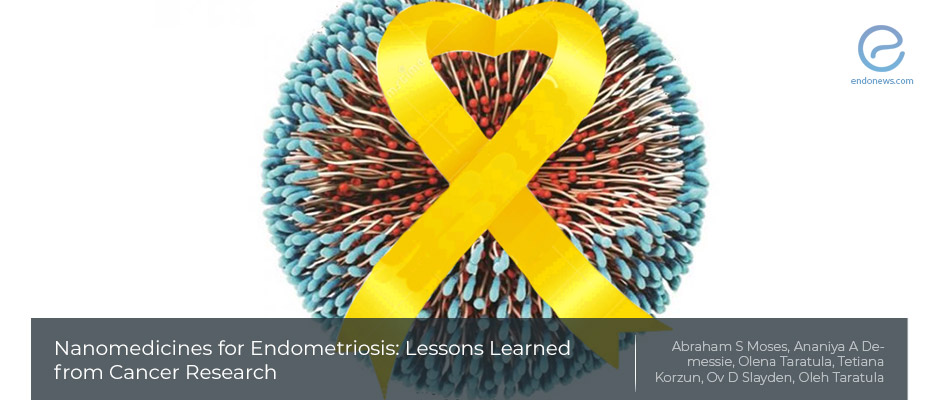Nanomedicines for Endometriosis
Mar 2, 2021
Applications of Lessons Learned from Cancer Research
Key Points
Highlight:
- Increasing numbers of reports demonstrate that nanoparticle-based strategies have the potential to provide novel therapeutic and diagnostic strategies for endometriosis.
Background:
- The absence of accurate, non-invasive, diagnostic tests and requirement of gold-standard laparoscopic surgery results in long delays for diagnosis for endometriosis patients.
- Medical therapies rely on hormonal manipulation, hence are not appropriate for long-term use and cause a diminished quality of life and disrupted fertility.
- There is a growing requirement for efficient non-surgical strategies for the diagnosis and treatment of endometriosis.
- Nanomaterials have been widely explored for imaging and treatment of various diseases, including cancer.
What has been done here?
- Dr. Taratula's group summarized how nanoparticle-based systems can improve endometriosis treatment and diagnosis.
- A systematic overview of the reported nanomedicine-based strategies, through discussing the potential mechanisms of nanoparticle accumulation and retention in endometriotic lesions was performed.
- An overview of animal models of endometriosis for nanoparticle evaluation and nanoparticle-based imaging strategies are summarized.
- Already reported nanoparticle-based therapeutic modalities along with their efficacy for endometriosis treatment was outlined.
- The possibility of using some fundamental principles of cancer nanomedicine in the imaging and treatment of endometriosis was discussed.
Key points:
- As endometriosis is a blood-vessel-rich and angiogenesis-dependent disease, passive targeting of nanoparticles through their "enhanced permeability and retention" effect.
- Nanoparticles with different compositions, surface functionalization, size, and surface charge escape from vessels and can accumulate in endometriosis by passive targeting.
- Using some overexpressed receptors in endometriosis, active targeting strategies designed for cancer could be adapted for endometriosis as well.
- Although morphologically similar, using the differentially expressed genes in eutopic endometrium and endometriosis, angiogenesis and progression of endometriosis could be interrupted for therapeutic purposes.
- There are several animal endometriosis models used to evaluate nanomedicines.
- Several research groups aimed to improve both MRI and laparoscopy using nanoparticles to deal with the current limitations in imaging and diagnosis of endometriosis, however, their efficacy should be tested in animal models and clinical trials.
- Experimental strategies for endometriosis gene therapy focusing on angiogenesis-inflammation inhibition, hormonal imbalance, and pain management are ongoing.
Conclusions:
- The application of nanomedicine for endometriosis is still in its infancy. However, nanoparticle-based strategies can shift the current paradigm for the diagnosis and treatment of endometriosis.
Lay Summary
Scientific research on nanoparticles is intense as they have many potential applications in medicine. Nanomaterials have been widely explored for imaging and treatment of various diseases, especially cancer, over the recent twenty years.
The absence of non-invasive diagnostic tests and inability of definitive diagnosis without gold-standard laparoscopic surgery, endometriosis patients face long diagnostic delays. Furthermore, diminished quality of life and disrupted fertility by medical hormonal therapies are the main reasons for the growing requirement of efficient non-surgical strategies for the diagnosis and treatment of endometriosis.
The application of nanoparticles for imaging and treatment of endometriosis is relatively a new field, however, an increasing number of reports demonstrate that nanoparticle-based strategies have the potential to provide novel therapeutic and diagnostic strategies for endometriosis as well.
In this systematic overview, Dr. Taratula group from Oregon State University summarized how nanoparticle-based systems can improve endometriosis treatment and diagnosis. This paper was recently published in the journal named “Small”.
Endometriosis is an angiogenesis-dependent disease, so it is reasonable to hypothesize that systemically injected nanoparticles accumulate in endometriotic lesions as well, by extravasation through immature, hyperpermeable blood vessels, which is a passive delivery. On the other hand, through the overexpressed receptors, active targeting aiming increasing retention and accumulation of passively delivered nanoparticles in targeted tissues is also possible.
For improving diagnostic MRI and laparoscopy several research groups aimed to use nanoparticles, however there is an urgent need to evaluate the efficacy of these techniques in relevant animal models and human clinical trials.
One of the exciting and challenging developments concerning nanoparticles in experimental medicine has been the emergence of gene therapy. Experimental strategies for gene therapy of endometriosis have focused primarily on inhibition of angiogenesis, addressing the hormonal imbalance, reducing inflammation, and attenuation of endometriosis-associated pain.
Although the application of nanomedicine for endometriosis is still in its infancy, the available reports suggest that nanoparticle-based strategies can shift the current paradigm for the diagnosis and treatment of endometriosis.
Research Source: https://pubmed.ncbi.nlm.nih.gov/33491876/
Endometriosis Imaging Nanomedicines Nanoparticles Therapies

